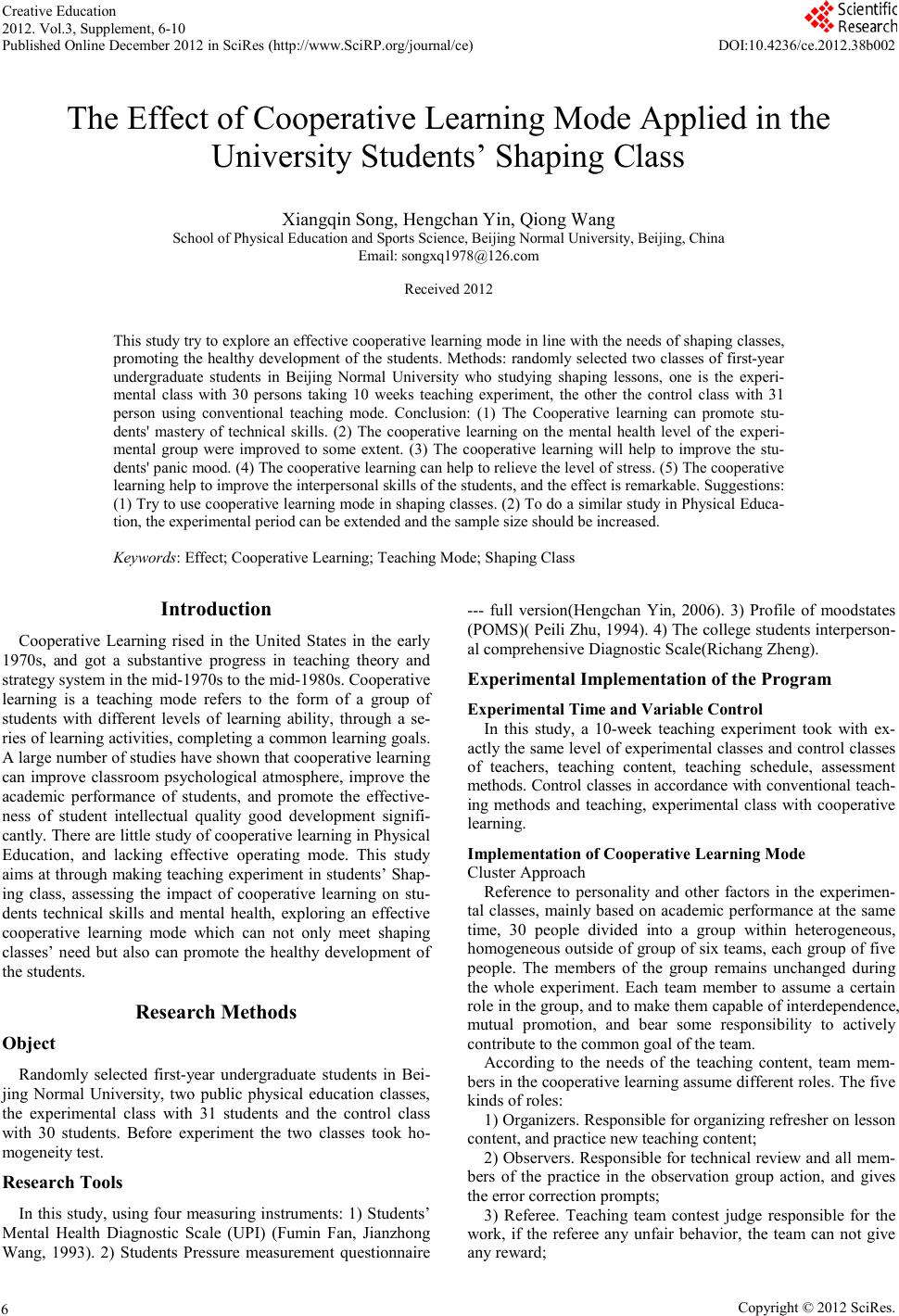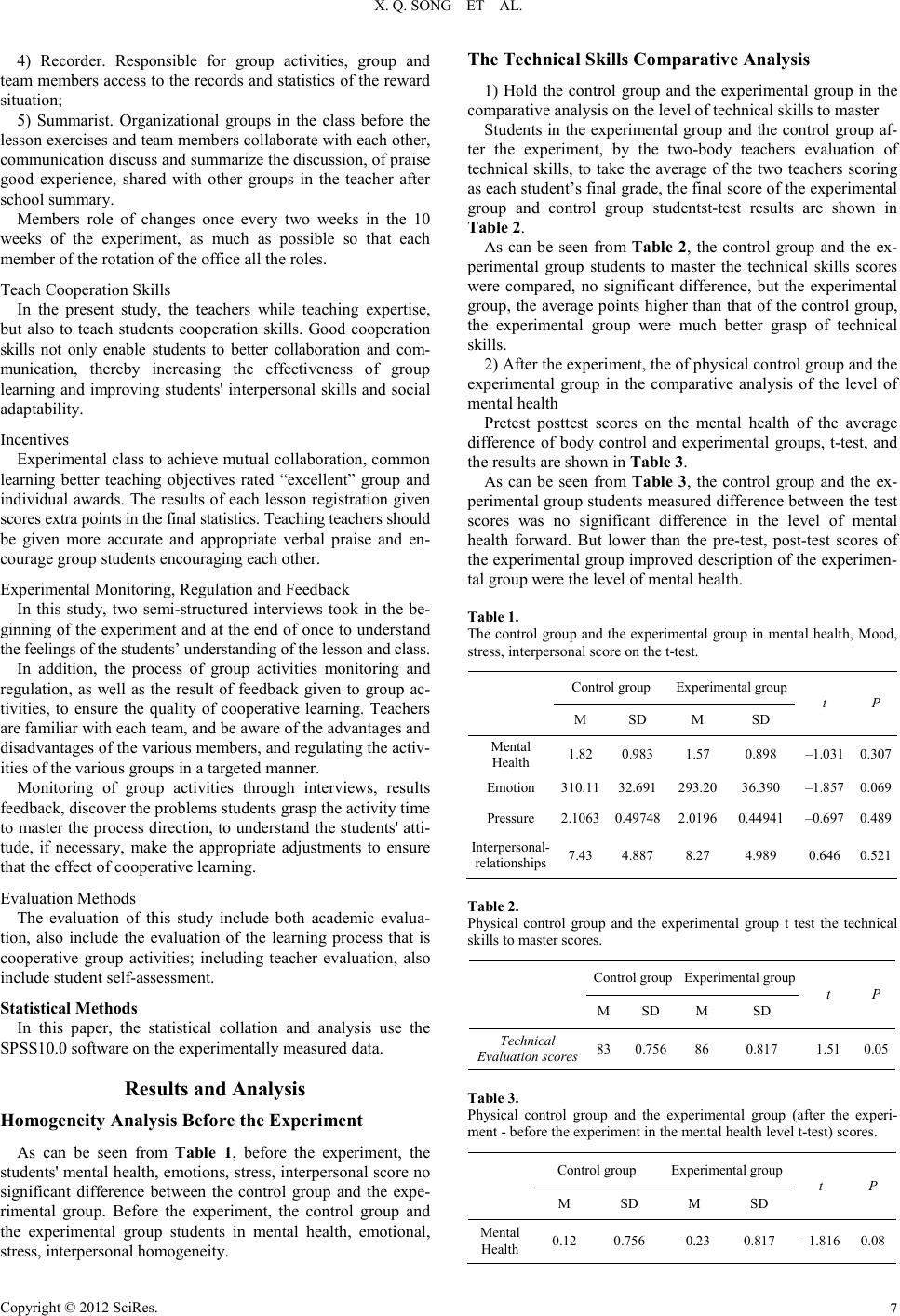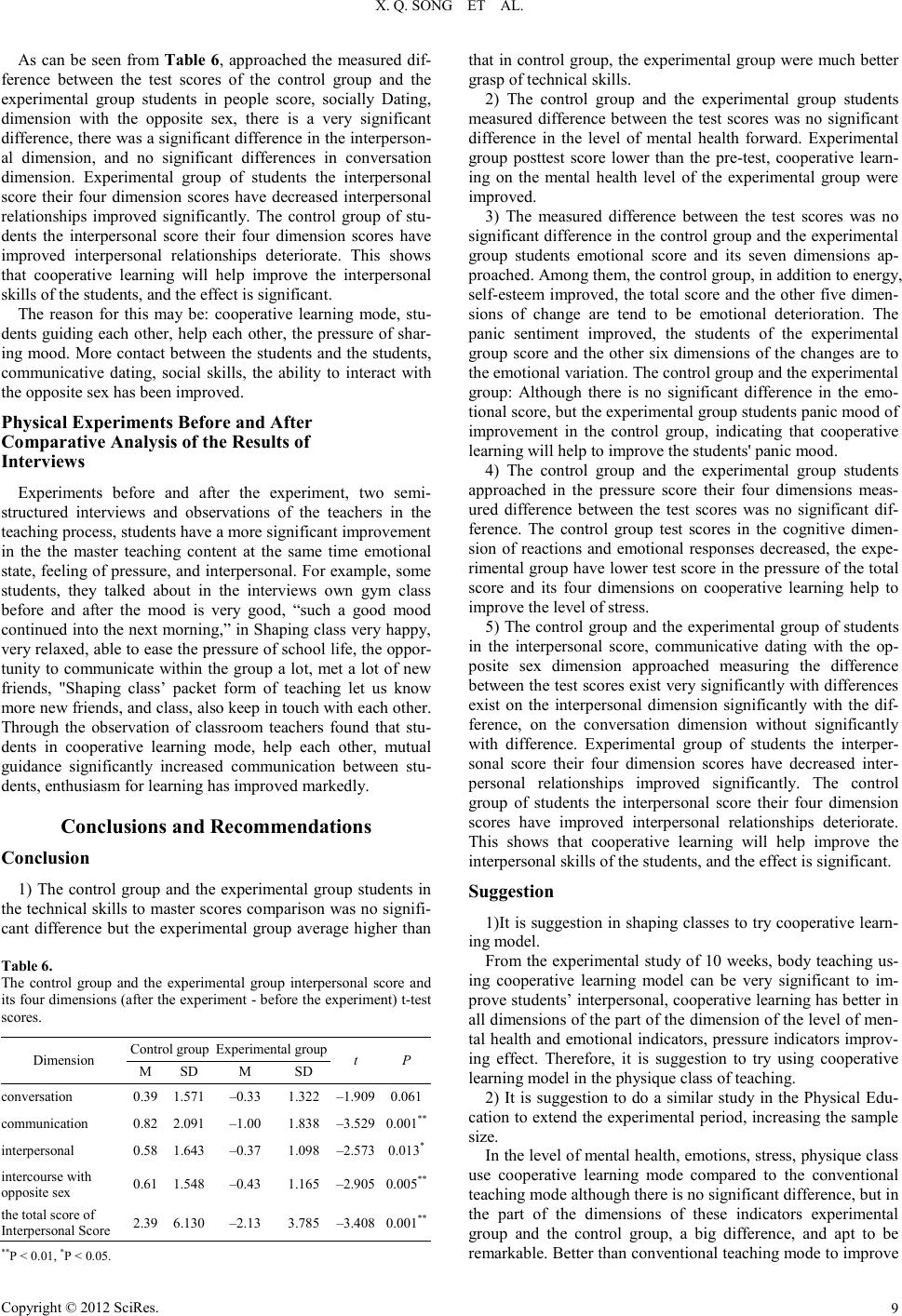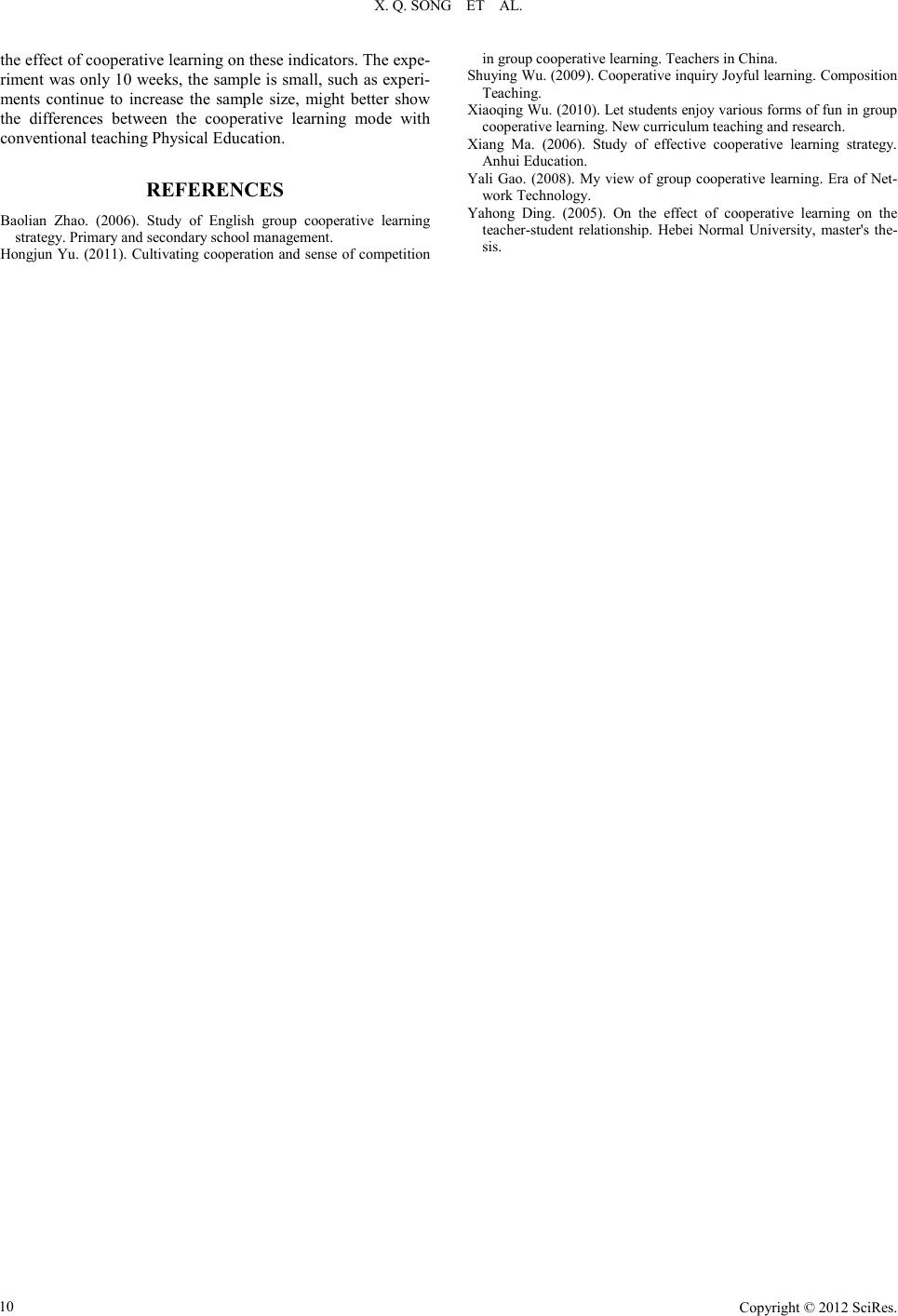Paper Menu >>
Journal Menu >>
 Creati v e Education 2012. Vol.3, Supplement, 6-10 Published Online December 2012 in SciRes (http://www.SciRP.org/journal/ce) DOI:10.4236/ce.2012.3 8b002 Copyright © 2012 SciRes. 6 The Effect of Cooperative Learning Mode Applied in the University Students’ Shaping Class Xiangqin Song, He ngchan Yin, Qiong Wang School of Physica l E ducation and Sports Sc ience, Beij ing Normal Uni vers ity, Beij ing, China Email: songxq1978@126.c om Received 2012 This st udy try to exp lore an ef fect ive cooper ati ve lear ning mode in l ine with t he needs of shap ing cl asses, promoti ng the health y develop ment of the s tudents. Methods : randomly selec ted two class es of first-year undergraduate students in Beijing Normal University who studying shaping lessons, one is the experi- mental class with 30 persons taking 10 weeks teaching experiment, the other the control class with 31 person using conventional teaching mode. Conclusion: (1) The Cooperative learning can promote stu- dents' mastery of technical skills. (2) The cooperative learning on the mental health level of the experi- mental group were improved to some extent. (3) The cooperative learning will help to improve the stu- dents' pa nic mood. (4 ) The c oop erat ive lea r ning c a n hel p t o reli eve t he le vel of s t ress . (5) The c oop era ti ve lear ni ng help to impr ove the i nter p ers ona l ski lls of the st udent s, and the ef f ect is r emar kabl e. Suggest ions : (1) Try to use c ooper at ive lea rning mode i n sha ping c lass es. (2) To do a simi lar s tudy in Ph ysica l Educa- tion, the experimental peri od can be ext ended and t he sa mp le size should be increased. Key words: Effect; Cooperative Learning; Teac hing Mode; S hapi ng Class Introduction Cooperative Learning rised in the United States in the early 1970s, and got a substantive progress in teaching theory and strategy system in the mid-1970s to the mid-1980s. Cooperative learning is a teaching mode refers to the form of a group of students with different levels of learning ability, through a se- ries of learnin g activities, completing a common learning goals. A large number of studies have shown that cooperative learning can improve classroom psychological atmosphere, improve the academic performance of students, and promote the effective- ness of student intellectual quality good development signifi- cantly. Ther e are litt le study of cooperative learning in Physical Education, and lacking effective operating mode. This study aims at th rough making teach ing exp eriment in students’ Shap- ing class, assessin g the impact of cooperative learning on stu- dents technical skills and mental health, exploring an effective cooperative learning mode which can not only meet shaping classes’ need but also can promote the healthy development of the students. Research Methods Object Randomly selected first-year undergraduate students in Bei- jing Normal University, two public physical education classes, the experimental class with 31 students and the control class with 30 students. Before experiment the two classes took ho- mogeneity test. Research Tools In this study, using four measuring instruments: 1) Students’ Mental Health Diagnostic Scale (UPI) (Fumin Fan, Jianzhong Wang, 1993). 2) Students Pressure measurement questionnaire --- full version(Hengchan Yin, 2006). 3) Profile of moodstates (POMS) ( P eili Zhu, 1994). 4) The college students interperson- al compreh ensive Diagnostic Scale(Richang Zheng). Experimental Implementation of the Program Experimental Time and Variable C ontrol In this study, a 10-week teaching experiment took with ex- actly the s ame level of exp erimental classes and co ntrol classes of teachers, teaching content, teaching schedule, assessment methods. Control classes in accordance with conventional teach- ing methods and teaching, experimental class with cooperative learning. Implementation of Cooper ative Learning Mode Cluster Approach Reference to personality and other factors in the experimen- tal classes, mainly based on acade mic perfor mance at the same time, 30 people divided into a group within heterogeneous, homogeneous outside of group of six teams, each group of five people. The members of the group remains unchanged during the whole experiment. Each team member to assume a certain role in the group, and to make them capable of interdependence, mutual promotion, and bear some responsibility to actively contribute to the common goal of the team. According to the needs of the teaching content, team mem- bers in the coo perat ive lear ni ng assume d ifferen t ro les. The fiv e kinds of roles: 1) Or ganizer s. Res pon sible for organizin g refresher on lesson cont ent, and practice new teachi ng cont ent; 2) Ob servers. Respo nsible for techn ical review and all mem- bers of the practice in the observation group action, and gives the error correction prompts; 3) Referee. Teaching team contest judge responsible for the work, if the referee any unfair behavior, the team can not give any reward ;  X. Q. SONG ET AL. Copyright © 2012 SciRes. 7 4) Recorder. Responsible for group activities, group and team members acce ss to the reco rds and statistics o f the reward situation; 5) Summarist. Organizational groups in the class before the lesson exercises an d team memb er s col lab orate with each o ther , communication discuss and summarize the discussion, of praise good experience, shared with other groups in the teacher after school summary. Members role of changes once every two weeks in the 10 weeks of the experiment, as much as possible so that each member of the rotation of the office all the roles. Teach Cooperation Skills In the present study, the teachers while teaching expertise, but also to teach students cooperation skills. Good cooperation skills not only enable students to better collaboration and com- munication, thereby increasing the effectiveness of group learning and improving students' interpersonal skills and social adaptability. Incent i ves Exper imental class to ach ieve mutu al coll aboration , common learning better teaching objectives rated “excell en t ” group and individual awards. The resu lts of each lesson registration given scores extra points in the final statistics. Teaching teachers should be given more accurate and appropriate verbal praise and en- courage group students encouraging each o ther. Experimental Monitoring, Regulation and Feedback In this study, two s e mi -structured interviews took in the be- ginning of the experiment and at the end of once to understand the fe e li ngs of the s t ude nts ’ unde rsta nding of the l ess on a nd c l a ss. In addition, the process of group activities monitoring and regulation, as well as the result of feedback given to group ac- tivities, to ensure the quality of cooperative learning. Teachers are familiar with each team, and be aware of the advantages an d disadvantages of the various members, and regulating the activ- ities of the various groups in a targeted manner. Monitoring of group activities through interviews, results feedback, discover the problems st udents grasp the acti vi ty time to master the process direction, to understand the students' atti- tude, if necessary, make the appropriate adjustments to ensure that t he effect of coo perative learning. Evaluation Methods The evaluation of this study include both academic evalua- tion, also include the evaluation of the learning process that is cooperative group activities; including teacher evaluation, also include student self-assessment. Statistical Methods In this paper, the statistical collation and analysis use the SPSS1 0.0 software on the experimentally measu r ed data. Results and Analysis Homogeneity Analysis Before the Experiment As can be seen from Table 1, before the experiment, the students' mental health, emotions, stress, int erperson al score no significant difference between the control group and the expe- rimental group. Before the experiment, the control group and the experimental group students in mental health, emotional, stress, interpersonal homogeneity. The Technical S kills Comparative A nalysis 1) Hold the control group and the experimental group in the comparative analysis on the level of technical skills t o master Students in the experimental group and the control group af- ter the experiment, by the two-body teachers evaluation of technical skills, to take the average of the two teachers scoring as each stu den t’s fin al grad e, t he final sco re o f the exp eri mental group and control group studentst-test results are shown in Table 2. As can be seen from Table 2, the control group and the ex- perimental group students to master the technical skills scores were compared, no significant difference, but the experimental group, the average points higher than that of the control group, the experimental group were much better grasp of technical skills. 2) After the experiment, the of physical control group and the experimental group in the comparative analysis of the level of mental health Pretest posttest scores on the mental health of the average difference of body control and experimental groups, t-test, and the results are shown in Table 3. As can be seen from Table 3, the control group and the ex- perimental group studen ts measured differen ce between the t est scores was no significant difference in the level of mental health forward. But lower than the pre-test, post-test scores of the experimental group improved description of the experimen- tal group were the level o f mental health. Table 1. The control group and the experimental group in mental health, Mood, str ess, interpersonal score on the t-test. Control group Experimental group t P M SD M SD Mental Health 1.82 0.983 1.57 0.898 –1.031 0.307 Emoti on 310.11 32.691 293.20 3 6.390 –1.857 0.069 Pressu r e 2.1063 0.49748 2.0196 0.44941 –0.697 0.489 Interpersonal- relati onships 7.43 4.887 8.27 4.989 0.646 0.521 Table 2. Physical control group and the experimental group t test the technical skills to master scores. Control gr oup Experimental group t P M SD M SD Technical Evaluat ion scores 83 0.756 86 0.817 1.51 0.05 Table 3. Physical control group and the experimental group (after the experi- ment - before the experi ment in the mental health lev el t-test) scores. Control group Experimental group t P M SD M SD Mental Health 0.12 0.756 –0.23 0.817 –1.816 0.08  X. Q. SONG ET AL. Copyright © 2012 SciRes. 8 Mental h ealth level of the t -test results there is no significant difference may be due to: the experiment was only 10 weeks, time is short, cooperative learning model figure teaching can not be formed on the level of mental health than conventional teachin g mode a significant effect. Reason may be lower than the pre-test post-test sco res of the experimental group as cooperative learning, students follow the group heterogeneity between groups the homogeneity principle of small groups within the group evaluation of the individual to the group's overall performance as the basis for team members to each other help, co mmon pro gress. Each me mber activ e pla y to their strengths, to help other team members, and the ar- rangement of the role of the different tasks within the group so that each member has the opportunity to contribute to the progress of the team. This mechanism makes each member's strengths has been the show will, insufficient relative to others the weaknes ses was always so meone to give a help ing hand, so the individual’s sense of accomplishment, frustration less, the level of mental health will naturally improve. 3) Experiment, body control group and the experimental group comparative analysis on the emotional Emotional score and its seven dimensions, body control and experimental groups approached measured the average differ- ence between the test scores of the t-test results are shown in Table 4. As can be seen from Table 4, the control group and the ex- perimental group students approached in the emotional score and its seven dimensions measured difference between the test scores were no significant differences. Among them, the control group, in addition to energy, self-esteem improved, the total score and the other five dimensions of change are tend to be emotional deterioration. The panic sentiment improved, the students of the experimental group score and the other six di- mensions of the changes are to the emotional variation. The control group and the experimental group: Although there is no significant difference in the emotional score, but the experi- mental group students panic emotional improvement was better than the control group. Table 4. Physical control group and the experimental group (after the experi- ment - before the experiment on the emotional score and its seven di- mensions t test) scores. Dimension Control group Experimental group t P M SD M SD tensity 1.64 8.161 1.60 8.950 –0.0 19 0.985 anger 1.82 6.254 0.17 9.907 –0.754 0.454 fatigue 1.75 7.787 0.00 11.8 09 –0.661 0.511 depression 0.29 5.943 0.37 7.810 0.044 0.965 energy 0.32 10.670 –0.77 19.488 –0.261 0.795 panic 0.39 9.162 –1.13 10.972 –0.573 0.569 self-esteem 2.32 11.072 –2.80 14.700 –1.490 0.142 the emo tiona l sco re 3.25 30.051 4.57 48.204 0.124 0.902 The reason may appear experimental group students panic mood is greatly alleviated the teaching mode. Learning task in the face o f cooperative l earning, team members collaborate with each other to resolve the various difficulties, improve learning efficiency, save your energy consumption, reduce panic mood naturally. Conventional teaching students more when they face a variety of learn ing tasks, fewer opportun ities to get help from others, and often will know what to do, resulting in the panic mood. Emotional t-test results there is no significant di fference may be due to: the experiment was 10 weeks shorter time coopera- tive learning model figure teaching can not be formed on the impact on the emotional level of the more significant effects than conventional teaching mode. 4) Experiment, body control group and the experimental group comparative analysis on the pressure Approached body of experimental and control groups in the pressure of the total score and its four dimensions measured the average difference between the test scores of the t-test results are shown in Tabl e 5. As can be seen from Table 5, the control group and the ex- perimental group students approached in the pressure score their four dimensions measured difference between the test scores was no significant difference. The control group test scores in the cognitive dimension of reactions and emotional responses decreased, the experimental group have lower test score in the pressure of the total score and its four dimensions on this pressure improvement in the experimental group were in the control group. The reasons for this situation: in the mode of cooperative learning, the students help each other, mutual guidance, in- creased communication and exchange, the pressure of sharing, so the pressure of the experimental class students and their improvement in the level of each dimension. Participation in sports activities can give vent to the negative emotions of stu- dents, reduce the pressure on students, the control group was an improvement in cognitive reactivity and emotional reaction dimension. 5) Experimental, comparative analysis of body control group and the experimental group on the interpersonal relationships Interpersonal score and its four dimensions, the the physical experimental group and control group approached measured the average difference between the test scores of the t-test results are shown in Tabl e 6. Table 5. Physical control group and the experimental group (experimental pres- sure score and its four dimensions - before the exp er iment) t-t est sco res. Dimension Contr ol group Experimen tal group t P M SD M SD Physi ological responses 0.12 0.396 –0.06 0.387 –1.731 0.089 Behavi or a l responses 0.04 0.460 –0.04 0.467 –0.678 0.501 Cognit ive responses –0.11 0.449 –0.14 0.605 –0.196 0.845 Emotional reactions –0.03 0.344 –0.12 0.609 –0.672 0.504 the total sc or e of Pressure 0.00 0.320 –0.09 0.401 –0.984 0.329  X. Q. SONG ET AL. Copyright © 2012 SciRes. 9 As can be seen from Table 6, approached the measured dif- ference between the test scores of the control group and the experimental group students in people score, socially Dating, dimension with the opposite sex, there is a very significant difference, there was a si gnifican t di fference in the in terperso n- al dimension, and no significant differences in conversation dimension. Experimental group of students the interpersonal score their four dimension scores have decreased interpersonal relationships improved significantly. The control group of stu- dents the interpersonal score their four dimension scores have improved interpersonal relationships deteriorate. This shows that cooperative learning will help improve the interpersonal skills of the students, and the effect is significant. The reason for this may be: cooperative learning mode, stu- dents guiding each other, help each other, the pressure of shar- ing mood. More contact b etween the stu dents and th e students, communicative dating, social skills, the ability to interact with the opposite sex has been improved. Physical Experiments Before and After Comparative Analysis of the Results of Intervie w s Experiments before and after the experiment, two semi- structured interviews and observations of the teachers in the teaching process, students have a more significant improvement in the the master teaching content at the same time emotional state, feel ing of pressu re, and interpersonal. For exa mpl e, s ome students, they talked about in the interviews own gym class before and after the mood is very good, “such a good mood continued into the next morning,” in Shaping class very happy, very relaxed , able t o ease th e pressu re of school life, the oppor- tunity to communicate within the group a lot, met a lot of new friends, "Shaping class’ packet form of teaching let us know more new friends, and class, also keep in touch with each other. Through the observation of classroom teachers found that stu- dents in cooperative learning mode, help each other, mutual guidance significantly increased communication between stu- dents, enthusiasm for learning has improved markedly. Conclusions and Recommendations Conclusion 1) The control group and the experimental group students in the tech nical skill s to master s cores co mparison was n o signifi- cant difference but the experimental group average higher than Table 6. The control group and the experimental group interpersonal score and its four dimensions (af ter the exp erimen t - b efore th e experimen t) t-test scor es. Dimension Control group Experimental group t P M SD M SD convers ation 0.39 1.571 –0.33 1.322 –1.909 0.061 communic ation 0.82 2.091 –1.00 1.838 –3.529 0.001** interpersonal 0.58 1.643 –0.37 1.098 –2.573 0.013* intercourse with opposite sex 0.6 1 1.548 –0.43 1.165 –2.905 0.005** the total sc ore of Interpersonal Score 2.39 6.130 –2.13 3.785 –3.408 0.001** **P < 0.01, *P < 0.05. that in control group, the experimental group were much better grasp of technical skills. 2) The control group and the experimental group students measured difference between the test scores was no significant difference in the level of mental health forward. Experimental group posttest score lower than the pre-test, cooperative learn- ing on the mental health level of the experimental group were improved. 3) The measured difference between the test scores was no significant difference in the control group and the experimental group students emotional score and its seven dimensions ap- proached. Among them, the control group, in addition to energy, self-esteem improved, the total score and the other five dimen- sions of change are tend to be emotional deterioration. The panic sentiment improved, the students of the experimental group score and the other six dimensions of the changes are to the emotional variation. The control group and the experimental group: Although there is no significant difference in the emo- tional score, but the experimental group students panic mood of improvement in the control group, indicating that cooperative learning will help to improve the students' panic mood. 4) The control group and the experimental group students approached in the pressure score their four dimensions meas- ured difference between the test scores was no significant dif- ference. The control group test scores in the cognitive dimen- sion of reactions and emotional responses decreased, the expe- rimental group have lower test score in the pressure of the total score and its four dimensions on cooperative learning help to improve the level of stress. 5) The control group and the experimental group of students in the interpersonal score, communicative dating with the op- posite sex dimension approached measuring the difference between th e test scores exist very significantly with differences exist on the interpersonal dimension significantly with the dif- ference, on the conversation dimension without significantly with difference. Experimental group of students the interper- sonal score their four dimension scores have decreased inter- personal relationships improved significantly. The control group of students the interpersonal score their four dimension scores have improved interpersonal relationships deteriorate. This shows that cooperative learning will help improve the interpersonal skills of the students, and the effect is significant. Suggestion 1)It is suggestio n in shaping classes t o try cooperati ve learn- ing model. From the experimental study of 10 weeks, body teaching us- ing cooperative learning model can be very significant to im- prove students’ interpers onal, coop erative lear nin g has bett er in all dimensions of the part of the dimension of the level of men- tal health and emotional indi cators, pressure indicato rs imp rov- ing effect. Therefore, it is suggestion to try using cooperative learning model in the physique class of teaching. 2) It is suggestion to do a similar study in the Physical Edu- cation to extend the experimental period, increasing the sample size. In the level of mental healt h, emotio ns, stress, physique class use cooperative learning mode compared to the conventional teaching mode although there is no significant difference, but in the part of the dimensions of these indicators experimental group and the control group, a big difference, and apt to be remarkable. Better than conventional teaching mode to improve  X. Q. SONG ET AL. Copyright © 2012 SciRes. 10 the effect o f coop erat ive learn in g on these i ndi cato rs. Th e expe- riment was only 10 weeks, t he sample is small, su ch as experi- ments continue to increase the sample size, might better show the differences between the cooperative learning mode with conven tional teaching Physical Education. REFERENCES Baolian Zhao. (2006). Study of English group cooperative learning strategy. Primary and secondary school management. Hongjun Yu. (2011). Cultivating cooperation and sense of competition in group cooperat ive learning. Teach ers in China. Shuying Wu. (2009). Coop erative inqu iry Joyful learn in g. Compos ition Teaching. Xiaoqi ng Wu. (2010) . Let stud ents enjoy va riou s forms of fu n in group cooperative learning. N ew c urriculum teaching an d research. Xiang Ma. (2006). Study of effective cooperative learning strategy. Anhui Education. Yali Gao. (2008). My view of group cooperative learning. Era of Net- work Technology. Yahong Ding. (2005). On the effect of cooperative learning on the tea cher-student relationship. Hebei Normal University, master's the- sis. |

